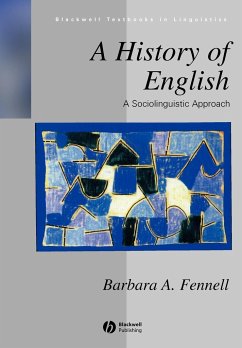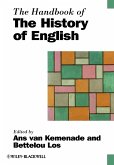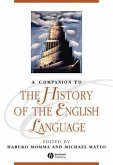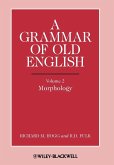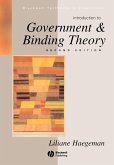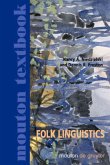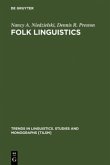- Broschiertes Buch
- Merkliste
- Auf die Merkliste
- Bewerten Bewerten
- Teilen
- Produkt teilen
- Produkterinnerung
- Produkterinnerung
A History of English provides an intelligent and accessible synthesis of modern sociolinguistic approaches to the development of the English language.
Beginning with the pre-history of English, each chapter provides sociohistorical context, an overview of the major structural changes at each stage of the language and discussion of topics of particular sociolinguistic interest. Textual examples are given from a number of genres of writing including classical literature, letters, prose writings, modern popular literature and software documentation. The volume concludes with a discussion of the future of English language.…mehr
Andere Kunden interessierten sich auch für
![The Handbook of the History of English The Handbook of the History of English]() The Handbook of the History of English83,99 €
The Handbook of the History of English83,99 €![A Companion to the History of the English Language A Companion to the History of the English Language]() Haruko MommaA Companion to the History of the English Language224,99 €
Haruko MommaA Companion to the History of the English Language224,99 €![Grammar of Old English V2 Grammar of Old English V2]() Richard M. HoggGrammar of Old English V2175,99 €
Richard M. HoggGrammar of Old English V2175,99 €![Introduction to Government and Binding Theory Introduction to Government and Binding Theory]() Liliane HaegemanIntroduction to Government and Binding Theory56,99 €
Liliane HaegemanIntroduction to Government and Binding Theory56,99 €![Folk Linguistics Folk Linguistics]() Nancy A. NiedzielskiFolk Linguistics33,99 €
Nancy A. NiedzielskiFolk Linguistics33,99 €![Folk Linguistics Folk Linguistics]() Nancy A. NiedzielskiFolk Linguistics199,95 €
Nancy A. NiedzielskiFolk Linguistics199,95 €![Introduction to Pragmatics Introduction to Pragmatics]() Betty J. BirnerIntroduction to Pragmatics48,99 €
Betty J. BirnerIntroduction to Pragmatics48,99 €-
-
-
A History of English provides an intelligent and accessible synthesis of modern sociolinguistic approaches to the development of the English language.
Beginning with the pre-history of English, each chapter provides sociohistorical context, an overview of the major structural changes at each stage of the language and discussion of topics of particular sociolinguistic interest. Textual examples are given from a number of genres of writing including classical literature, letters, prose writings, modern popular literature and software documentation. The volume concludes with a discussion of the future of English language.
Hinweis: Dieser Artikel kann nur an eine deutsche Lieferadresse ausgeliefert werden.
Beginning with the pre-history of English, each chapter provides sociohistorical context, an overview of the major structural changes at each stage of the language and discussion of topics of particular sociolinguistic interest. Textual examples are given from a number of genres of writing including classical literature, letters, prose writings, modern popular literature and software documentation. The volume concludes with a discussion of the future of English language.
Hinweis: Dieser Artikel kann nur an eine deutsche Lieferadresse ausgeliefert werden.
Produktdetails
- Produktdetails
- Blackwell Textbooks in Linguistics
- Verlag: Blackwell Publishers
- 1. Auflage
- Seitenzahl: 304
- Erscheinungstermin: 28. Dezember 2000
- Englisch
- Abmessung: 244mm x 170mm x 17mm
- Gewicht: 537g
- ISBN-13: 9780631200734
- ISBN-10: 0631200738
- Artikelnr.: 13598248
- Herstellerkennzeichnung
- Libri GmbH
- Europaallee 1
- 36244 Bad Hersfeld
- 06621 890
- Blackwell Textbooks in Linguistics
- Verlag: Blackwell Publishers
- 1. Auflage
- Seitenzahl: 304
- Erscheinungstermin: 28. Dezember 2000
- Englisch
- Abmessung: 244mm x 170mm x 17mm
- Gewicht: 537g
- ISBN-13: 9780631200734
- ISBN-10: 0631200738
- Artikelnr.: 13598248
- Herstellerkennzeichnung
- Libri GmbH
- Europaallee 1
- 36244 Bad Hersfeld
- 06621 890
Barbara A. Fennell is Senior Lecturer in Linguistics at the University of Aberdeen. She is the author of Language, Literature and the Negotiation of Identity (1998).
List of Maps and Figures xii
Acknowledgements xiii
1 Introduction 1
1.1 The Time Periods of English 1
1.2 Language Change 3
1.3 Sources of Information on Language Change 7
1.4 Linguistic Preliminaries 9
1.5 The Sounds of English, and Symbols Used to Describe Them 11
1.5.1 Consonants 11
1.5.2 Vowels 12
1.5.2.1 Monophthongs 12
1.5.2.2 Diphthongs 12
1.6 Structure of the Book 13
2 The Pre-history of English 15
Timeline: The Indo-European Period 15
2.1 The Indo-European Languages and Linguistic Relatedness 17
2.1.1 The Beginnings 17
2.1.2 The Development of Historical Linguistics 18
2.1.3 Genetic Relatedness 19
2.2 Linguistic Developments: The Indo-European Language Family 23
2.2.1 Family-Tree Relationships 23
2.2.2 The Indo-European Family 23
2.2.2.1 Indo-Iranian 25
2.2.2.2 Armenian 26
2.2.2.3 Albanian 26
2.2.2.4 Balto-Slavonic 26
2.2.2.5 Hellenic 28
2.2.2.6 Italic 28
2.2.2.7 Celtic 29
2.2.2.8 Germanic 31
2.3 From Indo-European to Germanic 34
2.3.1 Prosody 35
2.3.2 The Consonant System: Sound Shifts 35
2.3.2.1 Grimm's Law 36
2.3.2.2 Verner's Law 37
2.3.2.3 The Second Consonant Shift 38
2.3.3 The Vowel System 40
2.3.4 Morphology 40
2.3.5 Syntax 41
2.3.6 Lexicon 41
2.3.7 Semantics 42
2.3.8 Indo-European/Germanic Texts 42
2.3.9 Neogrammarians, Structuralists and Contemporary Linguistic Models 43
2.4 Typological Classification 44
2.4.1 Universals 45
2.4.1.1 Syntactic Universals 45
2.4.2 Morphological Typology 46
2.5 Sociolinguistic Focus. The Indo-European Tribes and the Spread of
Language. Language Contact and Language Change. Archaeological Linguistics
49
2.5.1 Language Contact 50
2.5.2 Archaeological Linguistics 51
2.6 Conclusion 53
3 Old English 55
Timeline: The Old English Period 55
3.1 Social and Political History 55
3.1.1 Britain before the English 55
3.1.2 The Anglo-Saxon Invasions 56
3.1.3 Anglo-Saxon Influence 56
3.1.4 Scandinavian Influence 57
3.2 Linguistic Developments: The Sounds, Structure and Typology of Old
English 59
3.2.1 The Structure of Old English 59
3.2.1.1 OE Consonants 60
3.2.1.2 Vowels: from Germanic to Old English 62
3.2.1.3 Old English Gender 64
3.2.1.4Inflection in Old English 64
3.2.1.5 Old English Syntax 72
3.2.1.6 Old English Vocabulary 77
3.3 Linguistic and Literary Achievements 79
3.3.1 Texts 79
3.3.1.1 Prose 80
3.3.1.2 Poetry 82
3.4 The Dialects of Old English 85
3.5 Sociolinguistic Focus 86
3.5.1 Language Contact 86
3.5.1.1 Latin and Celtic 88
3.5.1.2 The Scandinavians 90
4 Middle English 94
Timeline: The Middle English Period 94
4.1 Social and Political History 94
4.1.1 Political History: The Norman Conquest to Edward I 94
4.1.2 Social History 96
4.1.2.1 The Establishment of Towns and Burghs and the Beginnings of Social
Stratification 96
4.2 Linguistic Developments: Middle English Sounds and Structure, with
Particular Emphasis on the Breakdown of the Inflectional System and its
Linguistic Typological Implications 97
4.2.1 Major Changes in the Sound System 97
4.2.1.1 The Consonants 97
4.2.1.2 Consonant Changes from Old to Middle English 98
4.2.1.3 Vowels in Stressed Syllables 98
4.2.1.4 Vowels in Unstressed Syllables 99
4.2.1.5 Lengthening and Shortening 99
4.2.1.6 Summary Table of Vowel Changes from Old to Middle English 100
4.2.1.7 The Formation of Middle English Diphthongs 100
4.2.2 Major Morphological Changes from Old to Middle English 101
4.2.2.1 Loss of Inflections 101
4.2.2.2 Other Changes in the Morphological System 102
4.2.2.3 Verbs 103
4.2.3 Middle English Syntax 104
4.2.3.1 Word Order 106
4.2.4 The Lexicon: Loan Words from French 106
4.2.4.1 Numbers and Parts of the Body 107
4.2.4.2 Two French Sources 108
4.3 Middle English Dialects 108
4.3.1 Linguistic and Literary Achievements 114
4.3.1.1 Middle English Literature 114
4.3.2 Language 114
4.3.3 Genre 115
4.4 Sociolinguistic Focus: Social Stratification, Multilingualism and
Dialect Variation. Language Contact: The Myth of Middle English
Creolization 116
4.4.1 English Re-established 116
4.4.1.1 Language and the Rise of the Middle Class 120
4.4.2 The Development of Standard English 122
4.4.2.1 The Evolution of ME 'Standard' English 123
4.4.3 Middle English Creolization: Myth? 125
4.4.3.1 Definitions 126
4.4.3.2 Pidgins and Creoles in England? 128
4.5 Conclusion 133
5 Early Modern English 135
Timeline: The Early Modern English Period 135
5.1 Social and Political History 136
5.1.1 Historical and Political Background 136
5.1.1.1 Internal Instability and Colonial Expansion 137
5.2 Linguistic Developments: The Variable Character of Early Modern English
138
5.2.1 Phonology 138
5.2.1.1 Consonants 139
5.2.1.2 Vowels 140
5.2.1.3 The Great Vowel Shift 141
5.2.2 Morphology 141
5.2.2.1 Nouns 141
5.2.2.2 Pronouns 142
5.2.2.3 Adjectives and Adverbs 142
5.2.2.4 Verbs 143
5.2.2.5 The Spread of Northern Forms 143
5.2.3 Syntax 144
5.2.3.1 Periphrastic do 144
5.2.3.2 Progressive Verb Forms 145
5.2.3.3 Passives 145
5.2.4 Sample Text 146
5.2.5 Vocabulary 147
5.2.6 The Anxious State of English: The Search for Authority 147
5.2.6.1 Dictionaries and the Question of Linguistic Authority: Swift's and
Johnson's View of Language 149
5.3 Linguistic and Literary Achievement 152
5.4 Sociolinguistic Focus 154
5.4.1 Variation in Early Modern English 154
5.4.2 Standardization 156
5.4.2.1 The Printing Press 156
5.4.2.2 The Renaissance and the Protestant Reformation 156
5.4.2.3 English Established 157
5.4.3 The Great Vowel Shift 158
5.4.3.1 Phonological Change 158
5.4.4 Case Study: Power and Solidarity Relations in Early Modern English
162
5.5 Conclusion 166
6 Present-Day English 167
Timeline: Present-Day English 167
Introduction 168
6.1 Social and Political History 169
6.1.1 The Age of Revolutions, Wars and Imperialism 169
6.1.2 Urbanization, Industrialization and Social Stratification 170
6.2 Linguistic Developments 172
6.2.1 Morphology and Syntax 172
6.2.1.1 Morphology 172
6.2.1.2 Syntax 173
6.2.2 The Lexicon 175
6.2.2.1 Colonialism, Contact and Borrowings 175
6.2.2.2 Neologisms 176
6.2.2.3 Illustrative Texts 178
6.3 Modern English Dialects 179
6.3.1 Traditional Dialects 180
6.3.2 Modern Dialects 182
6.3.3 Received Pronunciation (RP): The Social Background 185
6.3.3.1 Characteristics of RP 187
6.3.4 RP, Estuary English and 'the Queen's English' 188
6.4 Sociolinguistic Focus: English in Scotland, Ireland and Wales -
Multilingualism in Britain 191
6.4.1 English in the British Isles 191
6.4.1.1 English in Scotland 191
6.4.1.2 English in Wales 195
6.4.1.3 English in Ireland 198
6.4.2 Immigrant Varieties of English in Britain 200
6.4.2.1 Immigration to Britain in the PDE Period 200
6.4.2.2 Colonial Immigration and Language 202
7 English in the United States 208
Timeline: America in the Modern Period 208
7.1 Social and Political History 209
7.1.1 Settlement and Language 209
7.1.2 Settlement by Region 210
7.1.2.1 The Original Thirteen Colonies 210
7.1.2.2 The Middle West 213
7.1.2.3 The South and West 214
7.2 The Development of American English 216
7.2.1 The Strength and Maintenance of Dialect Boundaries 216
7.2.2 How, Why and When American English Began to Diverge from British
English 217
7.2.2.1 Physical Separation 217
7.2.2.2 The Different Physical Conditions Encountered by the Settlers 218
7.2.2.3 Contact with Immigrant Non-Native Speakers of English 219
7.2.2.4 Developing Political Differences and the Growing American Sense of
National Identity 219
7.3 Language Variation in the United States 222
7.3.1 Uniformity and Diversity in Early American English 222
7.3.2 Regional Dialect Divisions in American English 223
7.3.2.1 The Lexicon 223
7.3.2.2 Phonology: Consonants 226
7.3.2.3 Phonology: Vowels 227
7.3.3 Social and Ethnic Dialects 229
7.3.3.1 Social Class and Language Change 231
7.3.3.2 Ethnicity 231
7.3.3.3 African-American Vernacular English 232
7.3.3.4 Traditional Dialects and the Resistance to Change 237
8 World-Wide English 241
Timeline: World-Wide English 241
8.1 Social and Political History: The Spread of English across the Globe
243
8.1.1 British Colonialism 244
8.1.1.1 Canada 244
8.1.1.2 The Caribbean 245
8.1.1.3 Australia 246
8.1.1.4New Zealand 247
8.1.1.5 South Africa 247
8.1.1.6 South Asia 248
8.1.1.7 Former Colonial Africa: West Africa 250
8.1.1.8 East Africa 252
8.1.1.9 South-East Asia and South Pacific 253
8.1.2 An Overview of the Use of English throughout the World 255
8.2 English as a Global Language 256
8.2.1 The Industrial Revolution 256
8.2.2 American Economic Superiority and Political Leadership 257
8.2.3 American Technological Domination 257
8.2.4 The Boom in English Language Teaching 258
8.2.5 The Need for a Global Language 259
8.2.6 Structural Considerations 260
8.2.7 Global and at the Same Time Local 261
8.3 English as a Killer Language 264
8.3.1 Language Death 265
8.3.2 Language and Communication Technology 266
8.4 The Future of English 267
Bibliography 270
Index 280
Acknowledgements xiii
1 Introduction 1
1.1 The Time Periods of English 1
1.2 Language Change 3
1.3 Sources of Information on Language Change 7
1.4 Linguistic Preliminaries 9
1.5 The Sounds of English, and Symbols Used to Describe Them 11
1.5.1 Consonants 11
1.5.2 Vowels 12
1.5.2.1 Monophthongs 12
1.5.2.2 Diphthongs 12
1.6 Structure of the Book 13
2 The Pre-history of English 15
Timeline: The Indo-European Period 15
2.1 The Indo-European Languages and Linguistic Relatedness 17
2.1.1 The Beginnings 17
2.1.2 The Development of Historical Linguistics 18
2.1.3 Genetic Relatedness 19
2.2 Linguistic Developments: The Indo-European Language Family 23
2.2.1 Family-Tree Relationships 23
2.2.2 The Indo-European Family 23
2.2.2.1 Indo-Iranian 25
2.2.2.2 Armenian 26
2.2.2.3 Albanian 26
2.2.2.4 Balto-Slavonic 26
2.2.2.5 Hellenic 28
2.2.2.6 Italic 28
2.2.2.7 Celtic 29
2.2.2.8 Germanic 31
2.3 From Indo-European to Germanic 34
2.3.1 Prosody 35
2.3.2 The Consonant System: Sound Shifts 35
2.3.2.1 Grimm's Law 36
2.3.2.2 Verner's Law 37
2.3.2.3 The Second Consonant Shift 38
2.3.3 The Vowel System 40
2.3.4 Morphology 40
2.3.5 Syntax 41
2.3.6 Lexicon 41
2.3.7 Semantics 42
2.3.8 Indo-European/Germanic Texts 42
2.3.9 Neogrammarians, Structuralists and Contemporary Linguistic Models 43
2.4 Typological Classification 44
2.4.1 Universals 45
2.4.1.1 Syntactic Universals 45
2.4.2 Morphological Typology 46
2.5 Sociolinguistic Focus. The Indo-European Tribes and the Spread of
Language. Language Contact and Language Change. Archaeological Linguistics
49
2.5.1 Language Contact 50
2.5.2 Archaeological Linguistics 51
2.6 Conclusion 53
3 Old English 55
Timeline: The Old English Period 55
3.1 Social and Political History 55
3.1.1 Britain before the English 55
3.1.2 The Anglo-Saxon Invasions 56
3.1.3 Anglo-Saxon Influence 56
3.1.4 Scandinavian Influence 57
3.2 Linguistic Developments: The Sounds, Structure and Typology of Old
English 59
3.2.1 The Structure of Old English 59
3.2.1.1 OE Consonants 60
3.2.1.2 Vowels: from Germanic to Old English 62
3.2.1.3 Old English Gender 64
3.2.1.4Inflection in Old English 64
3.2.1.5 Old English Syntax 72
3.2.1.6 Old English Vocabulary 77
3.3 Linguistic and Literary Achievements 79
3.3.1 Texts 79
3.3.1.1 Prose 80
3.3.1.2 Poetry 82
3.4 The Dialects of Old English 85
3.5 Sociolinguistic Focus 86
3.5.1 Language Contact 86
3.5.1.1 Latin and Celtic 88
3.5.1.2 The Scandinavians 90
4 Middle English 94
Timeline: The Middle English Period 94
4.1 Social and Political History 94
4.1.1 Political History: The Norman Conquest to Edward I 94
4.1.2 Social History 96
4.1.2.1 The Establishment of Towns and Burghs and the Beginnings of Social
Stratification 96
4.2 Linguistic Developments: Middle English Sounds and Structure, with
Particular Emphasis on the Breakdown of the Inflectional System and its
Linguistic Typological Implications 97
4.2.1 Major Changes in the Sound System 97
4.2.1.1 The Consonants 97
4.2.1.2 Consonant Changes from Old to Middle English 98
4.2.1.3 Vowels in Stressed Syllables 98
4.2.1.4 Vowels in Unstressed Syllables 99
4.2.1.5 Lengthening and Shortening 99
4.2.1.6 Summary Table of Vowel Changes from Old to Middle English 100
4.2.1.7 The Formation of Middle English Diphthongs 100
4.2.2 Major Morphological Changes from Old to Middle English 101
4.2.2.1 Loss of Inflections 101
4.2.2.2 Other Changes in the Morphological System 102
4.2.2.3 Verbs 103
4.2.3 Middle English Syntax 104
4.2.3.1 Word Order 106
4.2.4 The Lexicon: Loan Words from French 106
4.2.4.1 Numbers and Parts of the Body 107
4.2.4.2 Two French Sources 108
4.3 Middle English Dialects 108
4.3.1 Linguistic and Literary Achievements 114
4.3.1.1 Middle English Literature 114
4.3.2 Language 114
4.3.3 Genre 115
4.4 Sociolinguistic Focus: Social Stratification, Multilingualism and
Dialect Variation. Language Contact: The Myth of Middle English
Creolization 116
4.4.1 English Re-established 116
4.4.1.1 Language and the Rise of the Middle Class 120
4.4.2 The Development of Standard English 122
4.4.2.1 The Evolution of ME 'Standard' English 123
4.4.3 Middle English Creolization: Myth? 125
4.4.3.1 Definitions 126
4.4.3.2 Pidgins and Creoles in England? 128
4.5 Conclusion 133
5 Early Modern English 135
Timeline: The Early Modern English Period 135
5.1 Social and Political History 136
5.1.1 Historical and Political Background 136
5.1.1.1 Internal Instability and Colonial Expansion 137
5.2 Linguistic Developments: The Variable Character of Early Modern English
138
5.2.1 Phonology 138
5.2.1.1 Consonants 139
5.2.1.2 Vowels 140
5.2.1.3 The Great Vowel Shift 141
5.2.2 Morphology 141
5.2.2.1 Nouns 141
5.2.2.2 Pronouns 142
5.2.2.3 Adjectives and Adverbs 142
5.2.2.4 Verbs 143
5.2.2.5 The Spread of Northern Forms 143
5.2.3 Syntax 144
5.2.3.1 Periphrastic do 144
5.2.3.2 Progressive Verb Forms 145
5.2.3.3 Passives 145
5.2.4 Sample Text 146
5.2.5 Vocabulary 147
5.2.6 The Anxious State of English: The Search for Authority 147
5.2.6.1 Dictionaries and the Question of Linguistic Authority: Swift's and
Johnson's View of Language 149
5.3 Linguistic and Literary Achievement 152
5.4 Sociolinguistic Focus 154
5.4.1 Variation in Early Modern English 154
5.4.2 Standardization 156
5.4.2.1 The Printing Press 156
5.4.2.2 The Renaissance and the Protestant Reformation 156
5.4.2.3 English Established 157
5.4.3 The Great Vowel Shift 158
5.4.3.1 Phonological Change 158
5.4.4 Case Study: Power and Solidarity Relations in Early Modern English
162
5.5 Conclusion 166
6 Present-Day English 167
Timeline: Present-Day English 167
Introduction 168
6.1 Social and Political History 169
6.1.1 The Age of Revolutions, Wars and Imperialism 169
6.1.2 Urbanization, Industrialization and Social Stratification 170
6.2 Linguistic Developments 172
6.2.1 Morphology and Syntax 172
6.2.1.1 Morphology 172
6.2.1.2 Syntax 173
6.2.2 The Lexicon 175
6.2.2.1 Colonialism, Contact and Borrowings 175
6.2.2.2 Neologisms 176
6.2.2.3 Illustrative Texts 178
6.3 Modern English Dialects 179
6.3.1 Traditional Dialects 180
6.3.2 Modern Dialects 182
6.3.3 Received Pronunciation (RP): The Social Background 185
6.3.3.1 Characteristics of RP 187
6.3.4 RP, Estuary English and 'the Queen's English' 188
6.4 Sociolinguistic Focus: English in Scotland, Ireland and Wales -
Multilingualism in Britain 191
6.4.1 English in the British Isles 191
6.4.1.1 English in Scotland 191
6.4.1.2 English in Wales 195
6.4.1.3 English in Ireland 198
6.4.2 Immigrant Varieties of English in Britain 200
6.4.2.1 Immigration to Britain in the PDE Period 200
6.4.2.2 Colonial Immigration and Language 202
7 English in the United States 208
Timeline: America in the Modern Period 208
7.1 Social and Political History 209
7.1.1 Settlement and Language 209
7.1.2 Settlement by Region 210
7.1.2.1 The Original Thirteen Colonies 210
7.1.2.2 The Middle West 213
7.1.2.3 The South and West 214
7.2 The Development of American English 216
7.2.1 The Strength and Maintenance of Dialect Boundaries 216
7.2.2 How, Why and When American English Began to Diverge from British
English 217
7.2.2.1 Physical Separation 217
7.2.2.2 The Different Physical Conditions Encountered by the Settlers 218
7.2.2.3 Contact with Immigrant Non-Native Speakers of English 219
7.2.2.4 Developing Political Differences and the Growing American Sense of
National Identity 219
7.3 Language Variation in the United States 222
7.3.1 Uniformity and Diversity in Early American English 222
7.3.2 Regional Dialect Divisions in American English 223
7.3.2.1 The Lexicon 223
7.3.2.2 Phonology: Consonants 226
7.3.2.3 Phonology: Vowels 227
7.3.3 Social and Ethnic Dialects 229
7.3.3.1 Social Class and Language Change 231
7.3.3.2 Ethnicity 231
7.3.3.3 African-American Vernacular English 232
7.3.3.4 Traditional Dialects and the Resistance to Change 237
8 World-Wide English 241
Timeline: World-Wide English 241
8.1 Social and Political History: The Spread of English across the Globe
243
8.1.1 British Colonialism 244
8.1.1.1 Canada 244
8.1.1.2 The Caribbean 245
8.1.1.3 Australia 246
8.1.1.4New Zealand 247
8.1.1.5 South Africa 247
8.1.1.6 South Asia 248
8.1.1.7 Former Colonial Africa: West Africa 250
8.1.1.8 East Africa 252
8.1.1.9 South-East Asia and South Pacific 253
8.1.2 An Overview of the Use of English throughout the World 255
8.2 English as a Global Language 256
8.2.1 The Industrial Revolution 256
8.2.2 American Economic Superiority and Political Leadership 257
8.2.3 American Technological Domination 257
8.2.4 The Boom in English Language Teaching 258
8.2.5 The Need for a Global Language 259
8.2.6 Structural Considerations 260
8.2.7 Global and at the Same Time Local 261
8.3 English as a Killer Language 264
8.3.1 Language Death 265
8.3.2 Language and Communication Technology 266
8.4 The Future of English 267
Bibliography 270
Index 280
List of Maps and Figures xii
Acknowledgements xiii
1 Introduction 1
1.1 The Time Periods of English 1
1.2 Language Change 3
1.3 Sources of Information on Language Change 7
1.4 Linguistic Preliminaries 9
1.5 The Sounds of English, and Symbols Used to Describe Them 11
1.5.1 Consonants 11
1.5.2 Vowels 12
1.5.2.1 Monophthongs 12
1.5.2.2 Diphthongs 12
1.6 Structure of the Book 13
2 The Pre-history of English 15
Timeline: The Indo-European Period 15
2.1 The Indo-European Languages and Linguistic Relatedness 17
2.1.1 The Beginnings 17
2.1.2 The Development of Historical Linguistics 18
2.1.3 Genetic Relatedness 19
2.2 Linguistic Developments: The Indo-European Language Family 23
2.2.1 Family-Tree Relationships 23
2.2.2 The Indo-European Family 23
2.2.2.1 Indo-Iranian 25
2.2.2.2 Armenian 26
2.2.2.3 Albanian 26
2.2.2.4 Balto-Slavonic 26
2.2.2.5 Hellenic 28
2.2.2.6 Italic 28
2.2.2.7 Celtic 29
2.2.2.8 Germanic 31
2.3 From Indo-European to Germanic 34
2.3.1 Prosody 35
2.3.2 The Consonant System: Sound Shifts 35
2.3.2.1 Grimm's Law 36
2.3.2.2 Verner's Law 37
2.3.2.3 The Second Consonant Shift 38
2.3.3 The Vowel System 40
2.3.4 Morphology 40
2.3.5 Syntax 41
2.3.6 Lexicon 41
2.3.7 Semantics 42
2.3.8 Indo-European/Germanic Texts 42
2.3.9 Neogrammarians, Structuralists and Contemporary Linguistic Models 43
2.4 Typological Classification 44
2.4.1 Universals 45
2.4.1.1 Syntactic Universals 45
2.4.2 Morphological Typology 46
2.5 Sociolinguistic Focus. The Indo-European Tribes and the Spread of
Language. Language Contact and Language Change. Archaeological Linguistics
49
2.5.1 Language Contact 50
2.5.2 Archaeological Linguistics 51
2.6 Conclusion 53
3 Old English 55
Timeline: The Old English Period 55
3.1 Social and Political History 55
3.1.1 Britain before the English 55
3.1.2 The Anglo-Saxon Invasions 56
3.1.3 Anglo-Saxon Influence 56
3.1.4 Scandinavian Influence 57
3.2 Linguistic Developments: The Sounds, Structure and Typology of Old
English 59
3.2.1 The Structure of Old English 59
3.2.1.1 OE Consonants 60
3.2.1.2 Vowels: from Germanic to Old English 62
3.2.1.3 Old English Gender 64
3.2.1.4Inflection in Old English 64
3.2.1.5 Old English Syntax 72
3.2.1.6 Old English Vocabulary 77
3.3 Linguistic and Literary Achievements 79
3.3.1 Texts 79
3.3.1.1 Prose 80
3.3.1.2 Poetry 82
3.4 The Dialects of Old English 85
3.5 Sociolinguistic Focus 86
3.5.1 Language Contact 86
3.5.1.1 Latin and Celtic 88
3.5.1.2 The Scandinavians 90
4 Middle English 94
Timeline: The Middle English Period 94
4.1 Social and Political History 94
4.1.1 Political History: The Norman Conquest to Edward I 94
4.1.2 Social History 96
4.1.2.1 The Establishment of Towns and Burghs and the Beginnings of Social
Stratification 96
4.2 Linguistic Developments: Middle English Sounds and Structure, with
Particular Emphasis on the Breakdown of the Inflectional System and its
Linguistic Typological Implications 97
4.2.1 Major Changes in the Sound System 97
4.2.1.1 The Consonants 97
4.2.1.2 Consonant Changes from Old to Middle English 98
4.2.1.3 Vowels in Stressed Syllables 98
4.2.1.4 Vowels in Unstressed Syllables 99
4.2.1.5 Lengthening and Shortening 99
4.2.1.6 Summary Table of Vowel Changes from Old to Middle English 100
4.2.1.7 The Formation of Middle English Diphthongs 100
4.2.2 Major Morphological Changes from Old to Middle English 101
4.2.2.1 Loss of Inflections 101
4.2.2.2 Other Changes in the Morphological System 102
4.2.2.3 Verbs 103
4.2.3 Middle English Syntax 104
4.2.3.1 Word Order 106
4.2.4 The Lexicon: Loan Words from French 106
4.2.4.1 Numbers and Parts of the Body 107
4.2.4.2 Two French Sources 108
4.3 Middle English Dialects 108
4.3.1 Linguistic and Literary Achievements 114
4.3.1.1 Middle English Literature 114
4.3.2 Language 114
4.3.3 Genre 115
4.4 Sociolinguistic Focus: Social Stratification, Multilingualism and
Dialect Variation. Language Contact: The Myth of Middle English
Creolization 116
4.4.1 English Re-established 116
4.4.1.1 Language and the Rise of the Middle Class 120
4.4.2 The Development of Standard English 122
4.4.2.1 The Evolution of ME 'Standard' English 123
4.4.3 Middle English Creolization: Myth? 125
4.4.3.1 Definitions 126
4.4.3.2 Pidgins and Creoles in England? 128
4.5 Conclusion 133
5 Early Modern English 135
Timeline: The Early Modern English Period 135
5.1 Social and Political History 136
5.1.1 Historical and Political Background 136
5.1.1.1 Internal Instability and Colonial Expansion 137
5.2 Linguistic Developments: The Variable Character of Early Modern English
138
5.2.1 Phonology 138
5.2.1.1 Consonants 139
5.2.1.2 Vowels 140
5.2.1.3 The Great Vowel Shift 141
5.2.2 Morphology 141
5.2.2.1 Nouns 141
5.2.2.2 Pronouns 142
5.2.2.3 Adjectives and Adverbs 142
5.2.2.4 Verbs 143
5.2.2.5 The Spread of Northern Forms 143
5.2.3 Syntax 144
5.2.3.1 Periphrastic do 144
5.2.3.2 Progressive Verb Forms 145
5.2.3.3 Passives 145
5.2.4 Sample Text 146
5.2.5 Vocabulary 147
5.2.6 The Anxious State of English: The Search for Authority 147
5.2.6.1 Dictionaries and the Question of Linguistic Authority: Swift's and
Johnson's View of Language 149
5.3 Linguistic and Literary Achievement 152
5.4 Sociolinguistic Focus 154
5.4.1 Variation in Early Modern English 154
5.4.2 Standardization 156
5.4.2.1 The Printing Press 156
5.4.2.2 The Renaissance and the Protestant Reformation 156
5.4.2.3 English Established 157
5.4.3 The Great Vowel Shift 158
5.4.3.1 Phonological Change 158
5.4.4 Case Study: Power and Solidarity Relations in Early Modern English
162
5.5 Conclusion 166
6 Present-Day English 167
Timeline: Present-Day English 167
Introduction 168
6.1 Social and Political History 169
6.1.1 The Age of Revolutions, Wars and Imperialism 169
6.1.2 Urbanization, Industrialization and Social Stratification 170
6.2 Linguistic Developments 172
6.2.1 Morphology and Syntax 172
6.2.1.1 Morphology 172
6.2.1.2 Syntax 173
6.2.2 The Lexicon 175
6.2.2.1 Colonialism, Contact and Borrowings 175
6.2.2.2 Neologisms 176
6.2.2.3 Illustrative Texts 178
6.3 Modern English Dialects 179
6.3.1 Traditional Dialects 180
6.3.2 Modern Dialects 182
6.3.3 Received Pronunciation (RP): The Social Background 185
6.3.3.1 Characteristics of RP 187
6.3.4 RP, Estuary English and 'the Queen's English' 188
6.4 Sociolinguistic Focus: English in Scotland, Ireland and Wales -
Multilingualism in Britain 191
6.4.1 English in the British Isles 191
6.4.1.1 English in Scotland 191
6.4.1.2 English in Wales 195
6.4.1.3 English in Ireland 198
6.4.2 Immigrant Varieties of English in Britain 200
6.4.2.1 Immigration to Britain in the PDE Period 200
6.4.2.2 Colonial Immigration and Language 202
7 English in the United States 208
Timeline: America in the Modern Period 208
7.1 Social and Political History 209
7.1.1 Settlement and Language 209
7.1.2 Settlement by Region 210
7.1.2.1 The Original Thirteen Colonies 210
7.1.2.2 The Middle West 213
7.1.2.3 The South and West 214
7.2 The Development of American English 216
7.2.1 The Strength and Maintenance of Dialect Boundaries 216
7.2.2 How, Why and When American English Began to Diverge from British
English 217
7.2.2.1 Physical Separation 217
7.2.2.2 The Different Physical Conditions Encountered by the Settlers 218
7.2.2.3 Contact with Immigrant Non-Native Speakers of English 219
7.2.2.4 Developing Political Differences and the Growing American Sense of
National Identity 219
7.3 Language Variation in the United States 222
7.3.1 Uniformity and Diversity in Early American English 222
7.3.2 Regional Dialect Divisions in American English 223
7.3.2.1 The Lexicon 223
7.3.2.2 Phonology: Consonants 226
7.3.2.3 Phonology: Vowels 227
7.3.3 Social and Ethnic Dialects 229
7.3.3.1 Social Class and Language Change 231
7.3.3.2 Ethnicity 231
7.3.3.3 African-American Vernacular English 232
7.3.3.4 Traditional Dialects and the Resistance to Change 237
8 World-Wide English 241
Timeline: World-Wide English 241
8.1 Social and Political History: The Spread of English across the Globe
243
8.1.1 British Colonialism 244
8.1.1.1 Canada 244
8.1.1.2 The Caribbean 245
8.1.1.3 Australia 246
8.1.1.4New Zealand 247
8.1.1.5 South Africa 247
8.1.1.6 South Asia 248
8.1.1.7 Former Colonial Africa: West Africa 250
8.1.1.8 East Africa 252
8.1.1.9 South-East Asia and South Pacific 253
8.1.2 An Overview of the Use of English throughout the World 255
8.2 English as a Global Language 256
8.2.1 The Industrial Revolution 256
8.2.2 American Economic Superiority and Political Leadership 257
8.2.3 American Technological Domination 257
8.2.4 The Boom in English Language Teaching 258
8.2.5 The Need for a Global Language 259
8.2.6 Structural Considerations 260
8.2.7 Global and at the Same Time Local 261
8.3 English as a Killer Language 264
8.3.1 Language Death 265
8.3.2 Language and Communication Technology 266
8.4 The Future of English 267
Bibliography 270
Index 280
Acknowledgements xiii
1 Introduction 1
1.1 The Time Periods of English 1
1.2 Language Change 3
1.3 Sources of Information on Language Change 7
1.4 Linguistic Preliminaries 9
1.5 The Sounds of English, and Symbols Used to Describe Them 11
1.5.1 Consonants 11
1.5.2 Vowels 12
1.5.2.1 Monophthongs 12
1.5.2.2 Diphthongs 12
1.6 Structure of the Book 13
2 The Pre-history of English 15
Timeline: The Indo-European Period 15
2.1 The Indo-European Languages and Linguistic Relatedness 17
2.1.1 The Beginnings 17
2.1.2 The Development of Historical Linguistics 18
2.1.3 Genetic Relatedness 19
2.2 Linguistic Developments: The Indo-European Language Family 23
2.2.1 Family-Tree Relationships 23
2.2.2 The Indo-European Family 23
2.2.2.1 Indo-Iranian 25
2.2.2.2 Armenian 26
2.2.2.3 Albanian 26
2.2.2.4 Balto-Slavonic 26
2.2.2.5 Hellenic 28
2.2.2.6 Italic 28
2.2.2.7 Celtic 29
2.2.2.8 Germanic 31
2.3 From Indo-European to Germanic 34
2.3.1 Prosody 35
2.3.2 The Consonant System: Sound Shifts 35
2.3.2.1 Grimm's Law 36
2.3.2.2 Verner's Law 37
2.3.2.3 The Second Consonant Shift 38
2.3.3 The Vowel System 40
2.3.4 Morphology 40
2.3.5 Syntax 41
2.3.6 Lexicon 41
2.3.7 Semantics 42
2.3.8 Indo-European/Germanic Texts 42
2.3.9 Neogrammarians, Structuralists and Contemporary Linguistic Models 43
2.4 Typological Classification 44
2.4.1 Universals 45
2.4.1.1 Syntactic Universals 45
2.4.2 Morphological Typology 46
2.5 Sociolinguistic Focus. The Indo-European Tribes and the Spread of
Language. Language Contact and Language Change. Archaeological Linguistics
49
2.5.1 Language Contact 50
2.5.2 Archaeological Linguistics 51
2.6 Conclusion 53
3 Old English 55
Timeline: The Old English Period 55
3.1 Social and Political History 55
3.1.1 Britain before the English 55
3.1.2 The Anglo-Saxon Invasions 56
3.1.3 Anglo-Saxon Influence 56
3.1.4 Scandinavian Influence 57
3.2 Linguistic Developments: The Sounds, Structure and Typology of Old
English 59
3.2.1 The Structure of Old English 59
3.2.1.1 OE Consonants 60
3.2.1.2 Vowels: from Germanic to Old English 62
3.2.1.3 Old English Gender 64
3.2.1.4Inflection in Old English 64
3.2.1.5 Old English Syntax 72
3.2.1.6 Old English Vocabulary 77
3.3 Linguistic and Literary Achievements 79
3.3.1 Texts 79
3.3.1.1 Prose 80
3.3.1.2 Poetry 82
3.4 The Dialects of Old English 85
3.5 Sociolinguistic Focus 86
3.5.1 Language Contact 86
3.5.1.1 Latin and Celtic 88
3.5.1.2 The Scandinavians 90
4 Middle English 94
Timeline: The Middle English Period 94
4.1 Social and Political History 94
4.1.1 Political History: The Norman Conquest to Edward I 94
4.1.2 Social History 96
4.1.2.1 The Establishment of Towns and Burghs and the Beginnings of Social
Stratification 96
4.2 Linguistic Developments: Middle English Sounds and Structure, with
Particular Emphasis on the Breakdown of the Inflectional System and its
Linguistic Typological Implications 97
4.2.1 Major Changes in the Sound System 97
4.2.1.1 The Consonants 97
4.2.1.2 Consonant Changes from Old to Middle English 98
4.2.1.3 Vowels in Stressed Syllables 98
4.2.1.4 Vowels in Unstressed Syllables 99
4.2.1.5 Lengthening and Shortening 99
4.2.1.6 Summary Table of Vowel Changes from Old to Middle English 100
4.2.1.7 The Formation of Middle English Diphthongs 100
4.2.2 Major Morphological Changes from Old to Middle English 101
4.2.2.1 Loss of Inflections 101
4.2.2.2 Other Changes in the Morphological System 102
4.2.2.3 Verbs 103
4.2.3 Middle English Syntax 104
4.2.3.1 Word Order 106
4.2.4 The Lexicon: Loan Words from French 106
4.2.4.1 Numbers and Parts of the Body 107
4.2.4.2 Two French Sources 108
4.3 Middle English Dialects 108
4.3.1 Linguistic and Literary Achievements 114
4.3.1.1 Middle English Literature 114
4.3.2 Language 114
4.3.3 Genre 115
4.4 Sociolinguistic Focus: Social Stratification, Multilingualism and
Dialect Variation. Language Contact: The Myth of Middle English
Creolization 116
4.4.1 English Re-established 116
4.4.1.1 Language and the Rise of the Middle Class 120
4.4.2 The Development of Standard English 122
4.4.2.1 The Evolution of ME 'Standard' English 123
4.4.3 Middle English Creolization: Myth? 125
4.4.3.1 Definitions 126
4.4.3.2 Pidgins and Creoles in England? 128
4.5 Conclusion 133
5 Early Modern English 135
Timeline: The Early Modern English Period 135
5.1 Social and Political History 136
5.1.1 Historical and Political Background 136
5.1.1.1 Internal Instability and Colonial Expansion 137
5.2 Linguistic Developments: The Variable Character of Early Modern English
138
5.2.1 Phonology 138
5.2.1.1 Consonants 139
5.2.1.2 Vowels 140
5.2.1.3 The Great Vowel Shift 141
5.2.2 Morphology 141
5.2.2.1 Nouns 141
5.2.2.2 Pronouns 142
5.2.2.3 Adjectives and Adverbs 142
5.2.2.4 Verbs 143
5.2.2.5 The Spread of Northern Forms 143
5.2.3 Syntax 144
5.2.3.1 Periphrastic do 144
5.2.3.2 Progressive Verb Forms 145
5.2.3.3 Passives 145
5.2.4 Sample Text 146
5.2.5 Vocabulary 147
5.2.6 The Anxious State of English: The Search for Authority 147
5.2.6.1 Dictionaries and the Question of Linguistic Authority: Swift's and
Johnson's View of Language 149
5.3 Linguistic and Literary Achievement 152
5.4 Sociolinguistic Focus 154
5.4.1 Variation in Early Modern English 154
5.4.2 Standardization 156
5.4.2.1 The Printing Press 156
5.4.2.2 The Renaissance and the Protestant Reformation 156
5.4.2.3 English Established 157
5.4.3 The Great Vowel Shift 158
5.4.3.1 Phonological Change 158
5.4.4 Case Study: Power and Solidarity Relations in Early Modern English
162
5.5 Conclusion 166
6 Present-Day English 167
Timeline: Present-Day English 167
Introduction 168
6.1 Social and Political History 169
6.1.1 The Age of Revolutions, Wars and Imperialism 169
6.1.2 Urbanization, Industrialization and Social Stratification 170
6.2 Linguistic Developments 172
6.2.1 Morphology and Syntax 172
6.2.1.1 Morphology 172
6.2.1.2 Syntax 173
6.2.2 The Lexicon 175
6.2.2.1 Colonialism, Contact and Borrowings 175
6.2.2.2 Neologisms 176
6.2.2.3 Illustrative Texts 178
6.3 Modern English Dialects 179
6.3.1 Traditional Dialects 180
6.3.2 Modern Dialects 182
6.3.3 Received Pronunciation (RP): The Social Background 185
6.3.3.1 Characteristics of RP 187
6.3.4 RP, Estuary English and 'the Queen's English' 188
6.4 Sociolinguistic Focus: English in Scotland, Ireland and Wales -
Multilingualism in Britain 191
6.4.1 English in the British Isles 191
6.4.1.1 English in Scotland 191
6.4.1.2 English in Wales 195
6.4.1.3 English in Ireland 198
6.4.2 Immigrant Varieties of English in Britain 200
6.4.2.1 Immigration to Britain in the PDE Period 200
6.4.2.2 Colonial Immigration and Language 202
7 English in the United States 208
Timeline: America in the Modern Period 208
7.1 Social and Political History 209
7.1.1 Settlement and Language 209
7.1.2 Settlement by Region 210
7.1.2.1 The Original Thirteen Colonies 210
7.1.2.2 The Middle West 213
7.1.2.3 The South and West 214
7.2 The Development of American English 216
7.2.1 The Strength and Maintenance of Dialect Boundaries 216
7.2.2 How, Why and When American English Began to Diverge from British
English 217
7.2.2.1 Physical Separation 217
7.2.2.2 The Different Physical Conditions Encountered by the Settlers 218
7.2.2.3 Contact with Immigrant Non-Native Speakers of English 219
7.2.2.4 Developing Political Differences and the Growing American Sense of
National Identity 219
7.3 Language Variation in the United States 222
7.3.1 Uniformity and Diversity in Early American English 222
7.3.2 Regional Dialect Divisions in American English 223
7.3.2.1 The Lexicon 223
7.3.2.2 Phonology: Consonants 226
7.3.2.3 Phonology: Vowels 227
7.3.3 Social and Ethnic Dialects 229
7.3.3.1 Social Class and Language Change 231
7.3.3.2 Ethnicity 231
7.3.3.3 African-American Vernacular English 232
7.3.3.4 Traditional Dialects and the Resistance to Change 237
8 World-Wide English 241
Timeline: World-Wide English 241
8.1 Social and Political History: The Spread of English across the Globe
243
8.1.1 British Colonialism 244
8.1.1.1 Canada 244
8.1.1.2 The Caribbean 245
8.1.1.3 Australia 246
8.1.1.4New Zealand 247
8.1.1.5 South Africa 247
8.1.1.6 South Asia 248
8.1.1.7 Former Colonial Africa: West Africa 250
8.1.1.8 East Africa 252
8.1.1.9 South-East Asia and South Pacific 253
8.1.2 An Overview of the Use of English throughout the World 255
8.2 English as a Global Language 256
8.2.1 The Industrial Revolution 256
8.2.2 American Economic Superiority and Political Leadership 257
8.2.3 American Technological Domination 257
8.2.4 The Boom in English Language Teaching 258
8.2.5 The Need for a Global Language 259
8.2.6 Structural Considerations 260
8.2.7 Global and at the Same Time Local 261
8.3 English as a Killer Language 264
8.3.1 Language Death 265
8.3.2 Language and Communication Technology 266
8.4 The Future of English 267
Bibliography 270
Index 280

